Organizational Culture and Workforce Motivation: An ASDA Case Study
VerifiedAdded on 2023/06/14
|13
|3767
|335
Case Study
AI Summary
This case study explores the influence of organizational culture, politics, power, and motivation on individual and team behavior within ASDA. It examines ASDA's organizational culture, highlighting the importance of trust, teamwork, and role specialization. The report also discusses the impact of organizational politics and power dynamics, referencing French and Raven's bases of power, and analyzes motivation theories such as Maslow's hierarchy of needs and Adam's equity theory, demonstrating how ASDA addresses employee needs and fosters motivation through financial and non-financial incentives. The study concludes by differentiating between effective and ineffective teams and providing recommendations for ASDA to enhance its work culture and employee motivation. Desklib offers a range of study tools and solved assignments for students seeking further assistance.
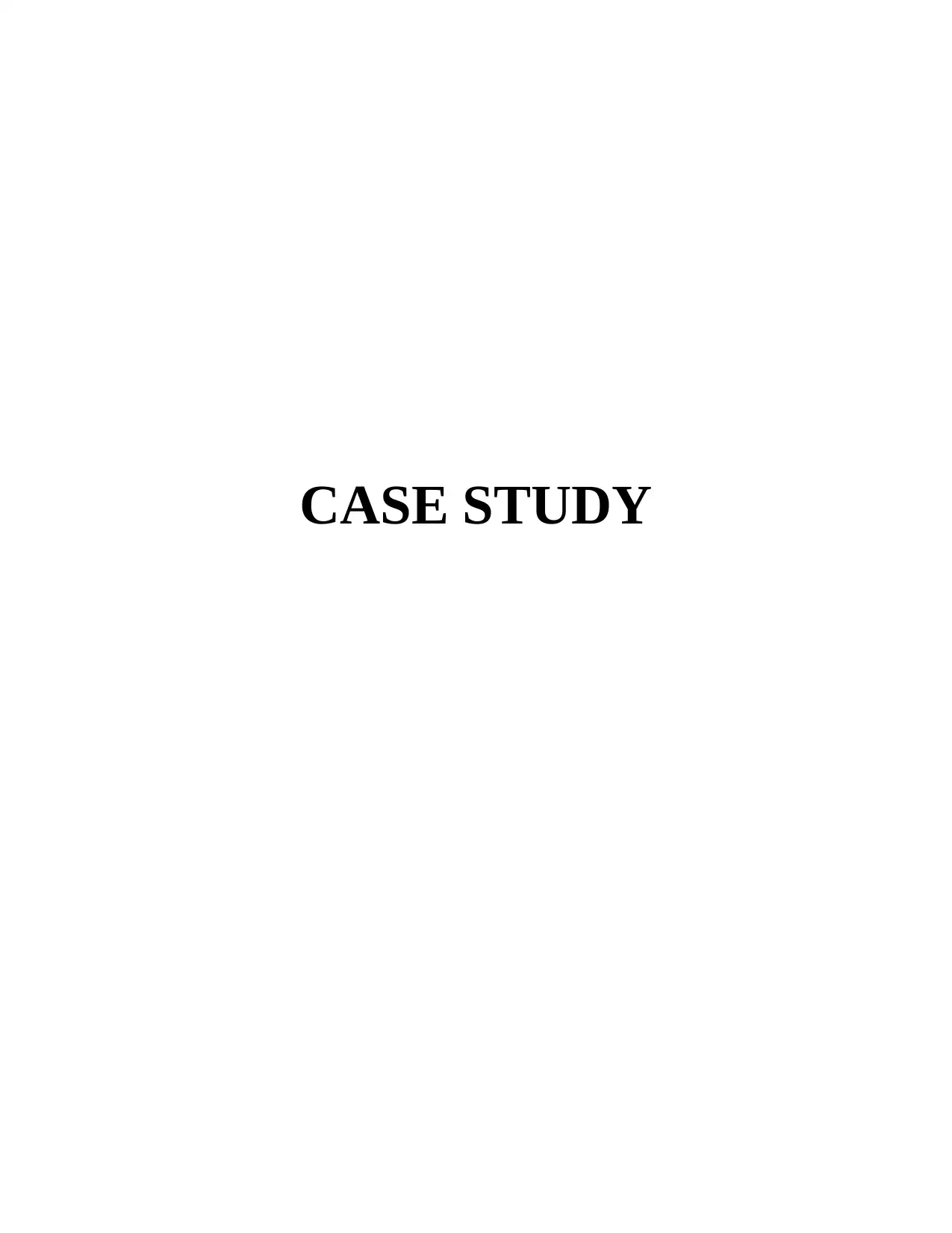
CASE STUDY
Paraphrase This Document
Need a fresh take? Get an instant paraphrase of this document with our AI Paraphraser
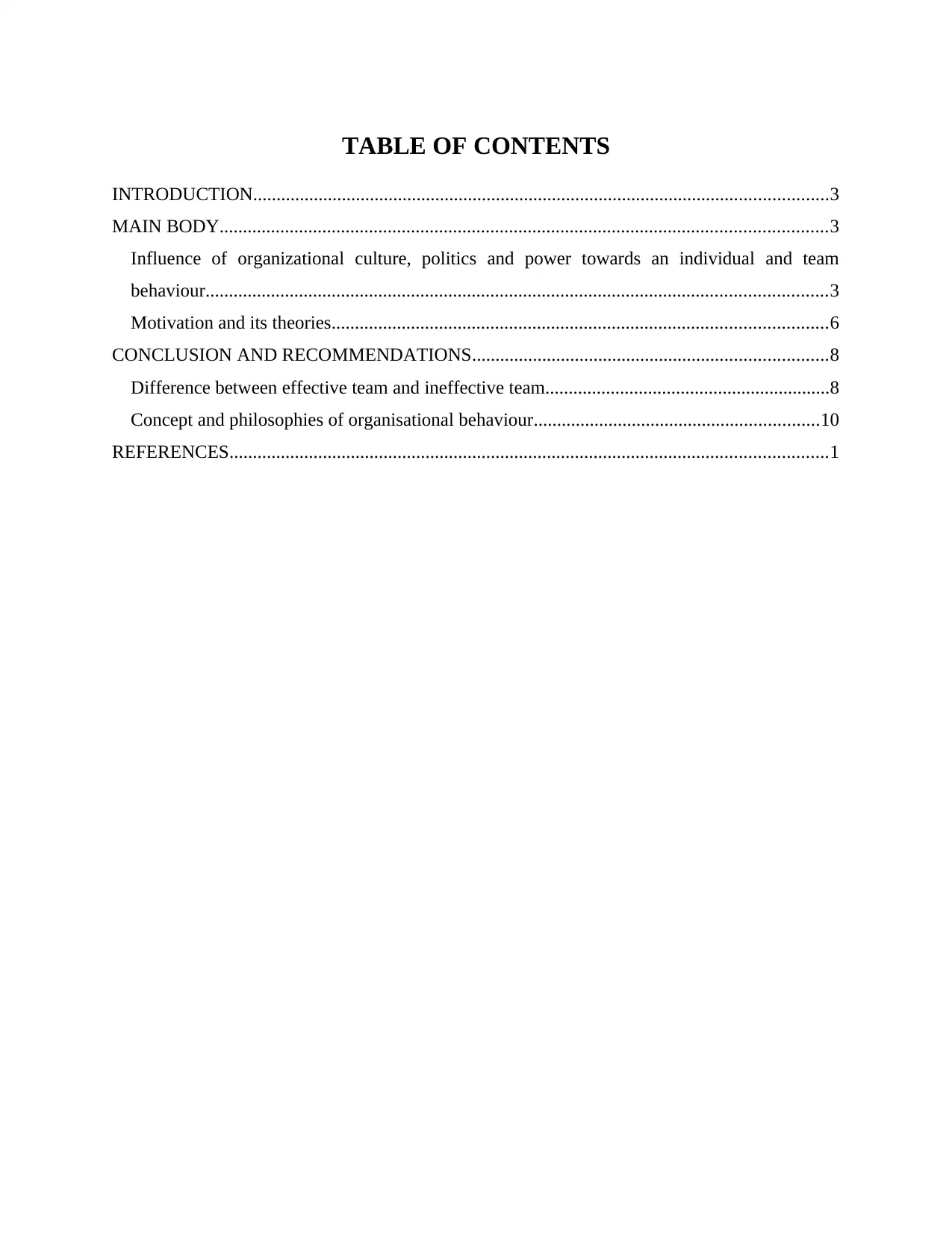
TABLE OF CONTENTS
INTRODUCTION...........................................................................................................................3
MAIN BODY..................................................................................................................................3
Influence of organizational culture, politics and power towards an individual and team
behaviour.....................................................................................................................................3
Motivation and its theories..........................................................................................................6
CONCLUSION AND RECOMMENDATIONS............................................................................8
Difference between effective team and ineffective team.............................................................8
Concept and philosophies of organisational behaviour.............................................................10
REFERENCES................................................................................................................................1
INTRODUCTION...........................................................................................................................3
MAIN BODY..................................................................................................................................3
Influence of organizational culture, politics and power towards an individual and team
behaviour.....................................................................................................................................3
Motivation and its theories..........................................................................................................6
CONCLUSION AND RECOMMENDATIONS............................................................................8
Difference between effective team and ineffective team.............................................................8
Concept and philosophies of organisational behaviour.............................................................10
REFERENCES................................................................................................................................1
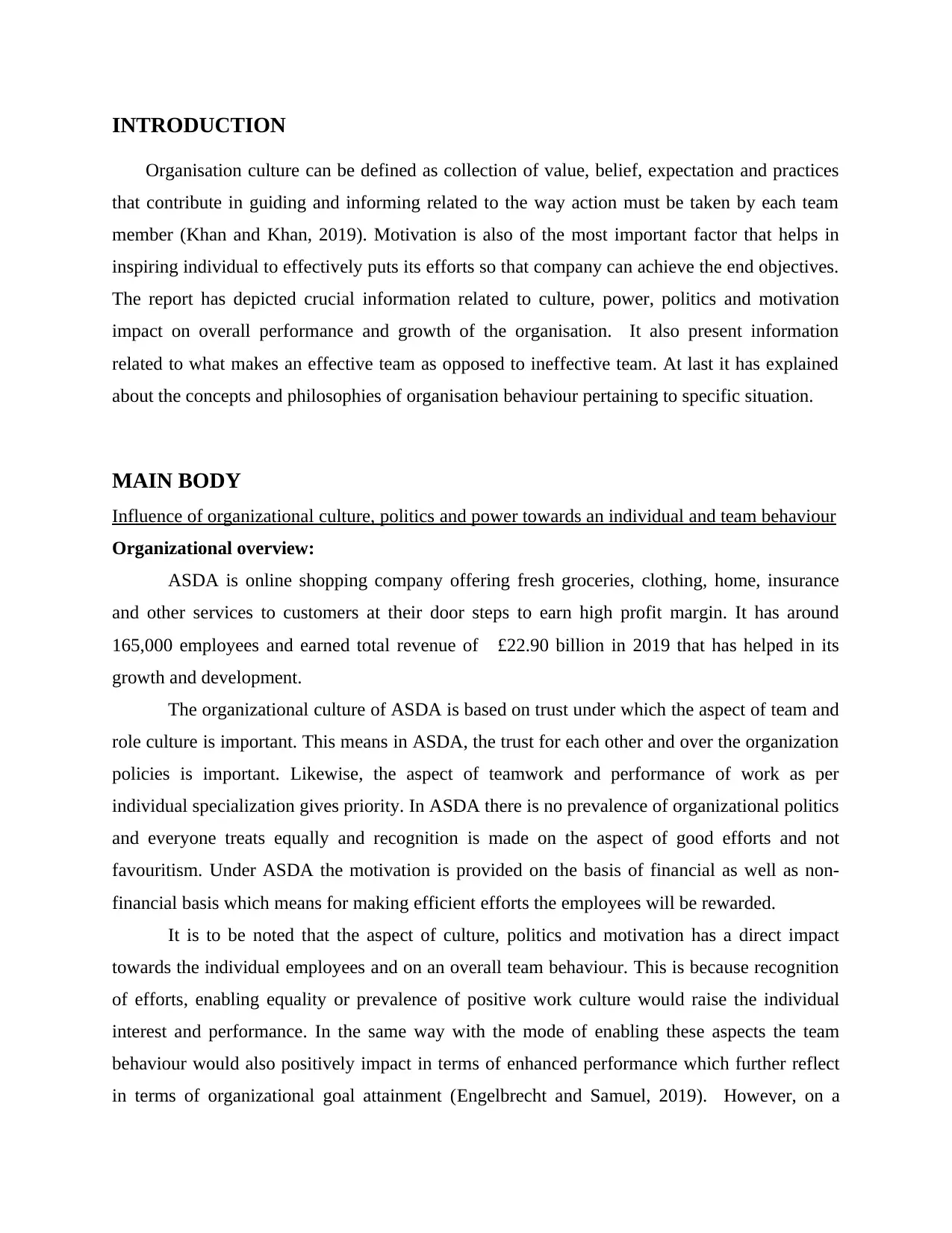
INTRODUCTION
Organisation culture can be defined as collection of value, belief, expectation and practices
that contribute in guiding and informing related to the way action must be taken by each team
member (Khan and Khan, 2019). Motivation is also of the most important factor that helps in
inspiring individual to effectively puts its efforts so that company can achieve the end objectives.
The report has depicted crucial information related to culture, power, politics and motivation
impact on overall performance and growth of the organisation. It also present information
related to what makes an effective team as opposed to ineffective team. At last it has explained
about the concepts and philosophies of organisation behaviour pertaining to specific situation.
MAIN BODY
Influence of organizational culture, politics and power towards an individual and team behaviour
Organizational overview:
ASDA is online shopping company offering fresh groceries, clothing, home, insurance
and other services to customers at their door steps to earn high profit margin. It has around
165,000 employees and earned total revenue of £22.90 billion in 2019 that has helped in its
growth and development.
The organizational culture of ASDA is based on trust under which the aspect of team and
role culture is important. This means in ASDA, the trust for each other and over the organization
policies is important. Likewise, the aspect of teamwork and performance of work as per
individual specialization gives priority. In ASDA there is no prevalence of organizational politics
and everyone treats equally and recognition is made on the aspect of good efforts and not
favouritism. Under ASDA the motivation is provided on the basis of financial as well as non-
financial basis which means for making efficient efforts the employees will be rewarded.
It is to be noted that the aspect of culture, politics and motivation has a direct impact
towards the individual employees and on an overall team behaviour. This is because recognition
of efforts, enabling equality or prevalence of positive work culture would raise the individual
interest and performance. In the same way with the mode of enabling these aspects the team
behaviour would also positively impact in terms of enhanced performance which further reflect
in terms of organizational goal attainment (Engelbrecht and Samuel, 2019). However, on a
Organisation culture can be defined as collection of value, belief, expectation and practices
that contribute in guiding and informing related to the way action must be taken by each team
member (Khan and Khan, 2019). Motivation is also of the most important factor that helps in
inspiring individual to effectively puts its efforts so that company can achieve the end objectives.
The report has depicted crucial information related to culture, power, politics and motivation
impact on overall performance and growth of the organisation. It also present information
related to what makes an effective team as opposed to ineffective team. At last it has explained
about the concepts and philosophies of organisation behaviour pertaining to specific situation.
MAIN BODY
Influence of organizational culture, politics and power towards an individual and team behaviour
Organizational overview:
ASDA is online shopping company offering fresh groceries, clothing, home, insurance
and other services to customers at their door steps to earn high profit margin. It has around
165,000 employees and earned total revenue of £22.90 billion in 2019 that has helped in its
growth and development.
The organizational culture of ASDA is based on trust under which the aspect of team and
role culture is important. This means in ASDA, the trust for each other and over the organization
policies is important. Likewise, the aspect of teamwork and performance of work as per
individual specialization gives priority. In ASDA there is no prevalence of organizational politics
and everyone treats equally and recognition is made on the aspect of good efforts and not
favouritism. Under ASDA the motivation is provided on the basis of financial as well as non-
financial basis which means for making efficient efforts the employees will be rewarded.
It is to be noted that the aspect of culture, politics and motivation has a direct impact
towards the individual employees and on an overall team behaviour. This is because recognition
of efforts, enabling equality or prevalence of positive work culture would raise the individual
interest and performance. In the same way with the mode of enabling these aspects the team
behaviour would also positively impact in terms of enhanced performance which further reflect
in terms of organizational goal attainment (Engelbrecht and Samuel, 2019). However, on a
⊘ This is a preview!⊘
Do you want full access?
Subscribe today to unlock all pages.

Trusted by 1+ million students worldwide
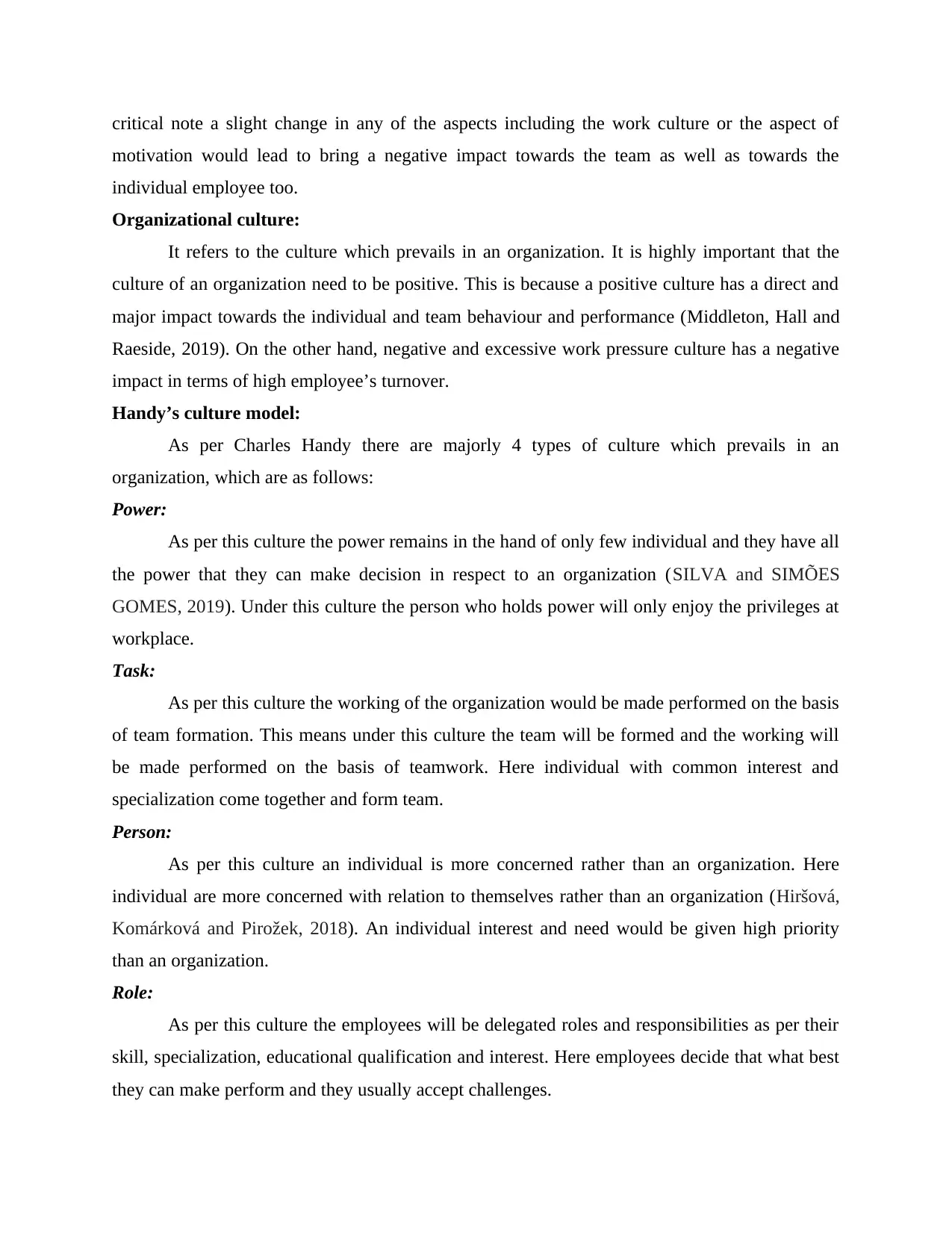
critical note a slight change in any of the aspects including the work culture or the aspect of
motivation would lead to bring a negative impact towards the team as well as towards the
individual employee too.
Organizational culture:
It refers to the culture which prevails in an organization. It is highly important that the
culture of an organization need to be positive. This is because a positive culture has a direct and
major impact towards the individual and team behaviour and performance (Middleton, Hall and
Raeside, 2019). On the other hand, negative and excessive work pressure culture has a negative
impact in terms of high employee’s turnover.
Handy’s culture model:
As per Charles Handy there are majorly 4 types of culture which prevails in an
organization, which are as follows:
Power:
As per this culture the power remains in the hand of only few individual and they have all
the power that they can make decision in respect to an organization (SILVA and SIMÕES
GOMES, 2019). Under this culture the person who holds power will only enjoy the privileges at
workplace.
Task:
As per this culture the working of the organization would be made performed on the basis
of team formation. This means under this culture the team will be formed and the working will
be made performed on the basis of teamwork. Here individual with common interest and
specialization come together and form team.
Person:
As per this culture an individual is more concerned rather than an organization. Here
individual are more concerned with relation to themselves rather than an organization (Hiršová,
Komárková and Pirožek, 2018). An individual interest and need would be given high priority
than an organization.
Role:
As per this culture the employees will be delegated roles and responsibilities as per their
skill, specialization, educational qualification and interest. Here employees decide that what best
they can make perform and they usually accept challenges.
motivation would lead to bring a negative impact towards the team as well as towards the
individual employee too.
Organizational culture:
It refers to the culture which prevails in an organization. It is highly important that the
culture of an organization need to be positive. This is because a positive culture has a direct and
major impact towards the individual and team behaviour and performance (Middleton, Hall and
Raeside, 2019). On the other hand, negative and excessive work pressure culture has a negative
impact in terms of high employee’s turnover.
Handy’s culture model:
As per Charles Handy there are majorly 4 types of culture which prevails in an
organization, which are as follows:
Power:
As per this culture the power remains in the hand of only few individual and they have all
the power that they can make decision in respect to an organization (SILVA and SIMÕES
GOMES, 2019). Under this culture the person who holds power will only enjoy the privileges at
workplace.
Task:
As per this culture the working of the organization would be made performed on the basis
of team formation. This means under this culture the team will be formed and the working will
be made performed on the basis of teamwork. Here individual with common interest and
specialization come together and form team.
Person:
As per this culture an individual is more concerned rather than an organization. Here
individual are more concerned with relation to themselves rather than an organization (Hiršová,
Komárková and Pirožek, 2018). An individual interest and need would be given high priority
than an organization.
Role:
As per this culture the employees will be delegated roles and responsibilities as per their
skill, specialization, educational qualification and interest. Here employees decide that what best
they can make perform and they usually accept challenges.
Paraphrase This Document
Need a fresh take? Get an instant paraphrase of this document with our AI Paraphraser
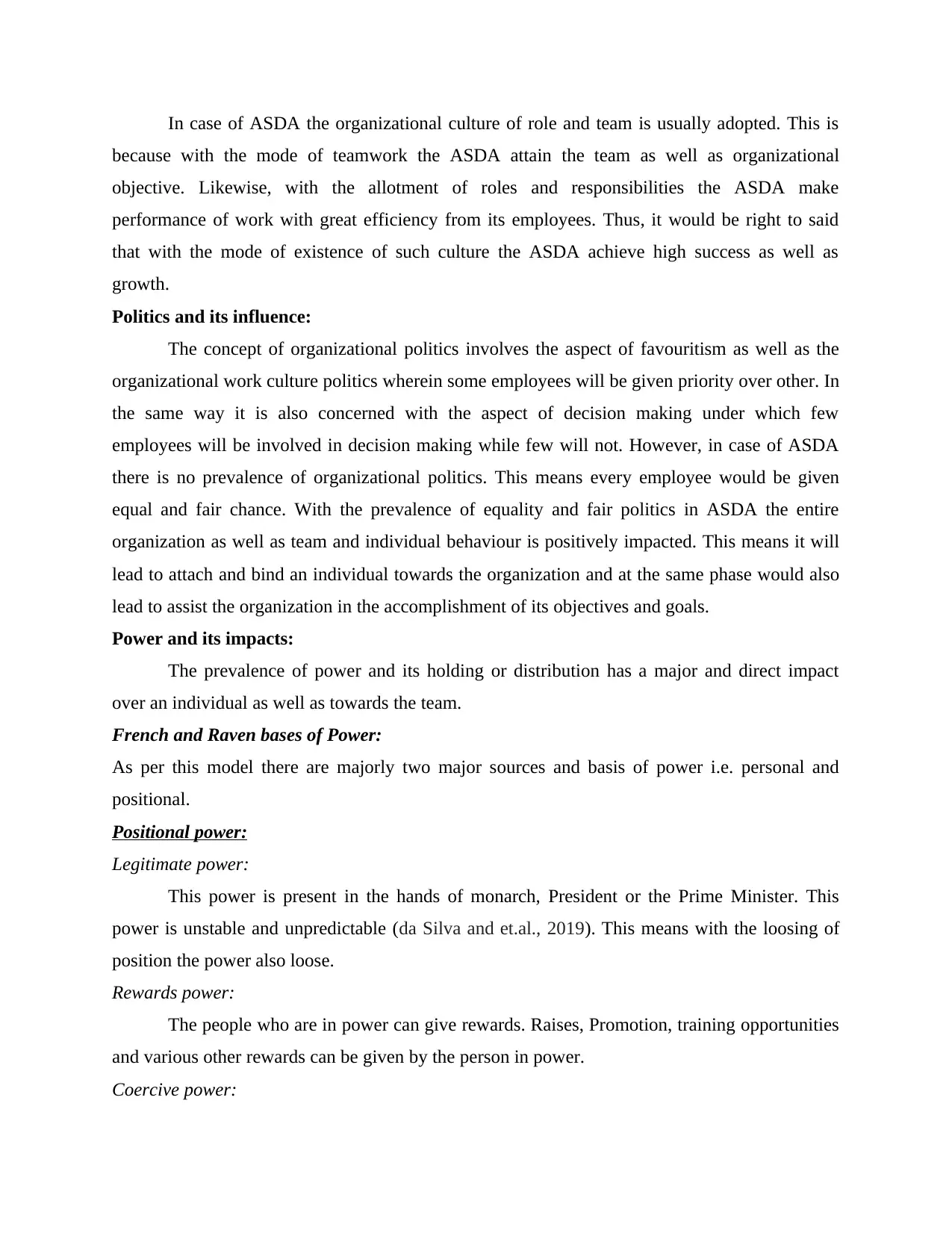
In case of ASDA the organizational culture of role and team is usually adopted. This is
because with the mode of teamwork the ASDA attain the team as well as organizational
objective. Likewise, with the allotment of roles and responsibilities the ASDA make
performance of work with great efficiency from its employees. Thus, it would be right to said
that with the mode of existence of such culture the ASDA achieve high success as well as
growth.
Politics and its influence:
The concept of organizational politics involves the aspect of favouritism as well as the
organizational work culture politics wherein some employees will be given priority over other. In
the same way it is also concerned with the aspect of decision making under which few
employees will be involved in decision making while few will not. However, in case of ASDA
there is no prevalence of organizational politics. This means every employee would be given
equal and fair chance. With the prevalence of equality and fair politics in ASDA the entire
organization as well as team and individual behaviour is positively impacted. This means it will
lead to attach and bind an individual towards the organization and at the same phase would also
lead to assist the organization in the accomplishment of its objectives and goals.
Power and its impacts:
The prevalence of power and its holding or distribution has a major and direct impact
over an individual as well as towards the team.
French and Raven bases of Power:
As per this model there are majorly two major sources and basis of power i.e. personal and
positional.
Positional power:
Legitimate power:
This power is present in the hands of monarch, President or the Prime Minister. This
power is unstable and unpredictable (da Silva and et.al., 2019). This means with the loosing of
position the power also loose.
Rewards power:
The people who are in power can give rewards. Raises, Promotion, training opportunities
and various other rewards can be given by the person in power.
Coercive power:
because with the mode of teamwork the ASDA attain the team as well as organizational
objective. Likewise, with the allotment of roles and responsibilities the ASDA make
performance of work with great efficiency from its employees. Thus, it would be right to said
that with the mode of existence of such culture the ASDA achieve high success as well as
growth.
Politics and its influence:
The concept of organizational politics involves the aspect of favouritism as well as the
organizational work culture politics wherein some employees will be given priority over other. In
the same way it is also concerned with the aspect of decision making under which few
employees will be involved in decision making while few will not. However, in case of ASDA
there is no prevalence of organizational politics. This means every employee would be given
equal and fair chance. With the prevalence of equality and fair politics in ASDA the entire
organization as well as team and individual behaviour is positively impacted. This means it will
lead to attach and bind an individual towards the organization and at the same phase would also
lead to assist the organization in the accomplishment of its objectives and goals.
Power and its impacts:
The prevalence of power and its holding or distribution has a major and direct impact
over an individual as well as towards the team.
French and Raven bases of Power:
As per this model there are majorly two major sources and basis of power i.e. personal and
positional.
Positional power:
Legitimate power:
This power is present in the hands of monarch, President or the Prime Minister. This
power is unstable and unpredictable (da Silva and et.al., 2019). This means with the loosing of
position the power also loose.
Rewards power:
The people who are in power can give rewards. Raises, Promotion, training opportunities
and various other rewards can be given by the person in power.
Coercive power:
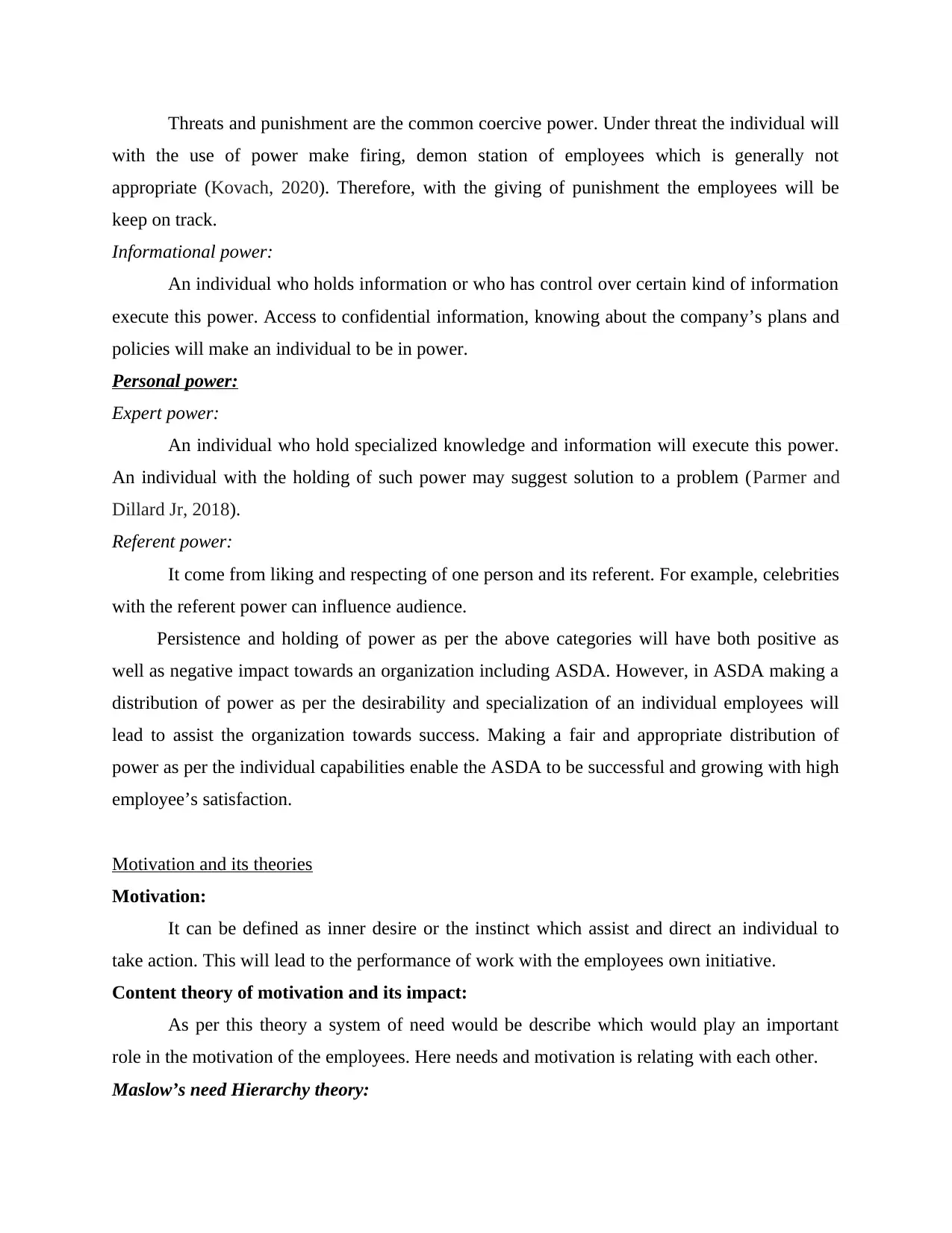
Threats and punishment are the common coercive power. Under threat the individual will
with the use of power make firing, demon station of employees which is generally not
appropriate (Kovach, 2020). Therefore, with the giving of punishment the employees will be
keep on track.
Informational power:
An individual who holds information or who has control over certain kind of information
execute this power. Access to confidential information, knowing about the company’s plans and
policies will make an individual to be in power.
Personal power:
Expert power:
An individual who hold specialized knowledge and information will execute this power.
An individual with the holding of such power may suggest solution to a problem (Parmer and
Dillard Jr, 2018).
Referent power:
It come from liking and respecting of one person and its referent. For example, celebrities
with the referent power can influence audience.
Persistence and holding of power as per the above categories will have both positive as
well as negative impact towards an organization including ASDA. However, in ASDA making a
distribution of power as per the desirability and specialization of an individual employees will
lead to assist the organization towards success. Making a fair and appropriate distribution of
power as per the individual capabilities enable the ASDA to be successful and growing with high
employee’s satisfaction.
Motivation and its theories
Motivation:
It can be defined as inner desire or the instinct which assist and direct an individual to
take action. This will lead to the performance of work with the employees own initiative.
Content theory of motivation and its impact:
As per this theory a system of need would be describe which would play an important
role in the motivation of the employees. Here needs and motivation is relating with each other.
Maslow’s need Hierarchy theory:
with the use of power make firing, demon station of employees which is generally not
appropriate (Kovach, 2020). Therefore, with the giving of punishment the employees will be
keep on track.
Informational power:
An individual who holds information or who has control over certain kind of information
execute this power. Access to confidential information, knowing about the company’s plans and
policies will make an individual to be in power.
Personal power:
Expert power:
An individual who hold specialized knowledge and information will execute this power.
An individual with the holding of such power may suggest solution to a problem (Parmer and
Dillard Jr, 2018).
Referent power:
It come from liking and respecting of one person and its referent. For example, celebrities
with the referent power can influence audience.
Persistence and holding of power as per the above categories will have both positive as
well as negative impact towards an organization including ASDA. However, in ASDA making a
distribution of power as per the desirability and specialization of an individual employees will
lead to assist the organization towards success. Making a fair and appropriate distribution of
power as per the individual capabilities enable the ASDA to be successful and growing with high
employee’s satisfaction.
Motivation and its theories
Motivation:
It can be defined as inner desire or the instinct which assist and direct an individual to
take action. This will lead to the performance of work with the employees own initiative.
Content theory of motivation and its impact:
As per this theory a system of need would be describe which would play an important
role in the motivation of the employees. Here needs and motivation is relating with each other.
Maslow’s need Hierarchy theory:
⊘ This is a preview!⊘
Do you want full access?
Subscribe today to unlock all pages.

Trusted by 1+ million students worldwide
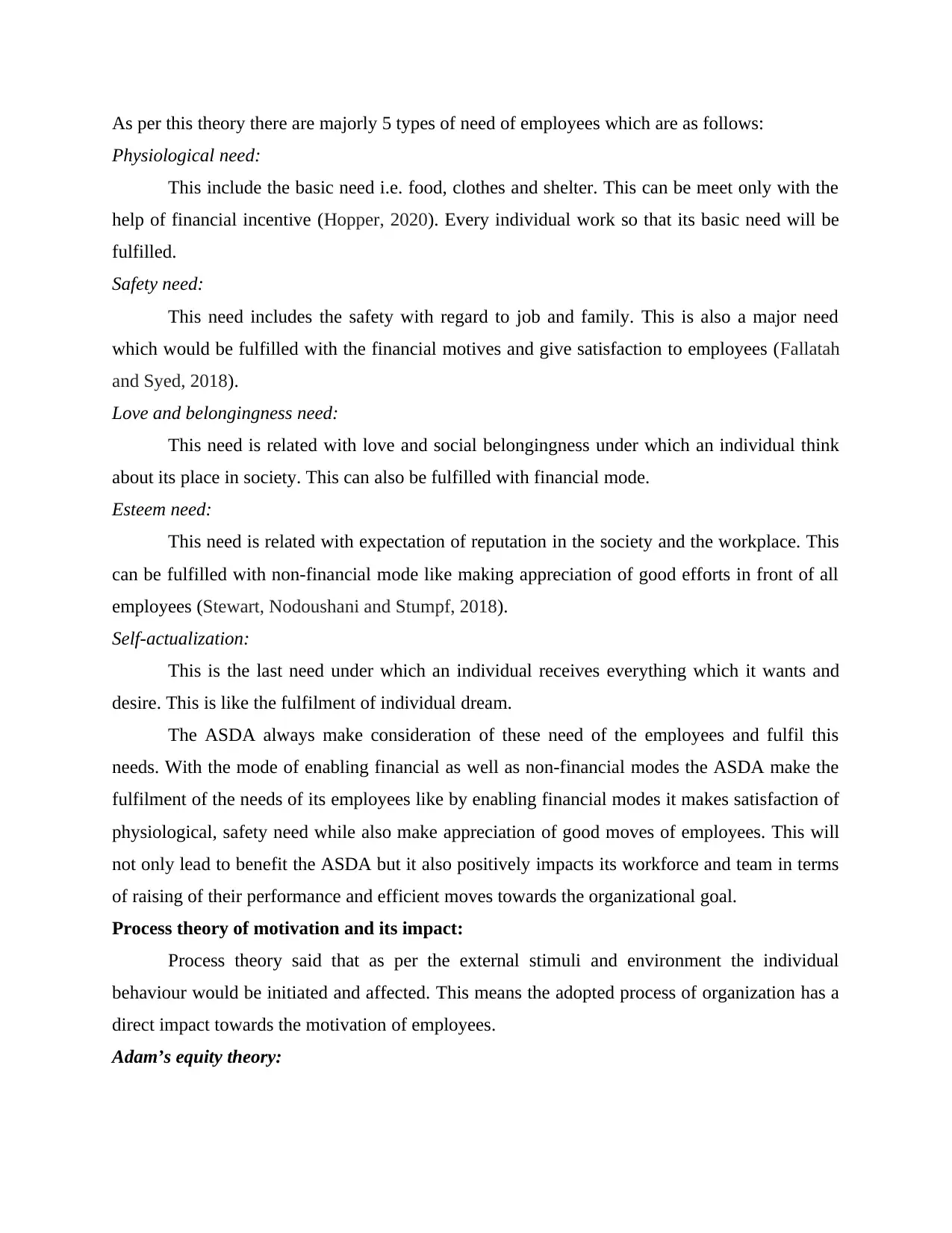
As per this theory there are majorly 5 types of need of employees which are as follows:
Physiological need:
This include the basic need i.e. food, clothes and shelter. This can be meet only with the
help of financial incentive (Hopper, 2020). Every individual work so that its basic need will be
fulfilled.
Safety need:
This need includes the safety with regard to job and family. This is also a major need
which would be fulfilled with the financial motives and give satisfaction to employees (Fallatah
and Syed, 2018).
Love and belongingness need:
This need is related with love and social belongingness under which an individual think
about its place in society. This can also be fulfilled with financial mode.
Esteem need:
This need is related with expectation of reputation in the society and the workplace. This
can be fulfilled with non-financial mode like making appreciation of good efforts in front of all
employees (Stewart, Nodoushani and Stumpf, 2018).
Self-actualization:
This is the last need under which an individual receives everything which it wants and
desire. This is like the fulfilment of individual dream.
The ASDA always make consideration of these need of the employees and fulfil this
needs. With the mode of enabling financial as well as non-financial modes the ASDA make the
fulfilment of the needs of its employees like by enabling financial modes it makes satisfaction of
physiological, safety need while also make appreciation of good moves of employees. This will
not only lead to benefit the ASDA but it also positively impacts its workforce and team in terms
of raising of their performance and efficient moves towards the organizational goal.
Process theory of motivation and its impact:
Process theory said that as per the external stimuli and environment the individual
behaviour would be initiated and affected. This means the adopted process of organization has a
direct impact towards the motivation of employees.
Adam’s equity theory:
Physiological need:
This include the basic need i.e. food, clothes and shelter. This can be meet only with the
help of financial incentive (Hopper, 2020). Every individual work so that its basic need will be
fulfilled.
Safety need:
This need includes the safety with regard to job and family. This is also a major need
which would be fulfilled with the financial motives and give satisfaction to employees (Fallatah
and Syed, 2018).
Love and belongingness need:
This need is related with love and social belongingness under which an individual think
about its place in society. This can also be fulfilled with financial mode.
Esteem need:
This need is related with expectation of reputation in the society and the workplace. This
can be fulfilled with non-financial mode like making appreciation of good efforts in front of all
employees (Stewart, Nodoushani and Stumpf, 2018).
Self-actualization:
This is the last need under which an individual receives everything which it wants and
desire. This is like the fulfilment of individual dream.
The ASDA always make consideration of these need of the employees and fulfil this
needs. With the mode of enabling financial as well as non-financial modes the ASDA make the
fulfilment of the needs of its employees like by enabling financial modes it makes satisfaction of
physiological, safety need while also make appreciation of good moves of employees. This will
not only lead to benefit the ASDA but it also positively impacts its workforce and team in terms
of raising of their performance and efficient moves towards the organizational goal.
Process theory of motivation and its impact:
Process theory said that as per the external stimuli and environment the individual
behaviour would be initiated and affected. This means the adopted process of organization has a
direct impact towards the motivation of employees.
Adam’s equity theory:
Paraphrase This Document
Need a fresh take? Get an instant paraphrase of this document with our AI Paraphraser
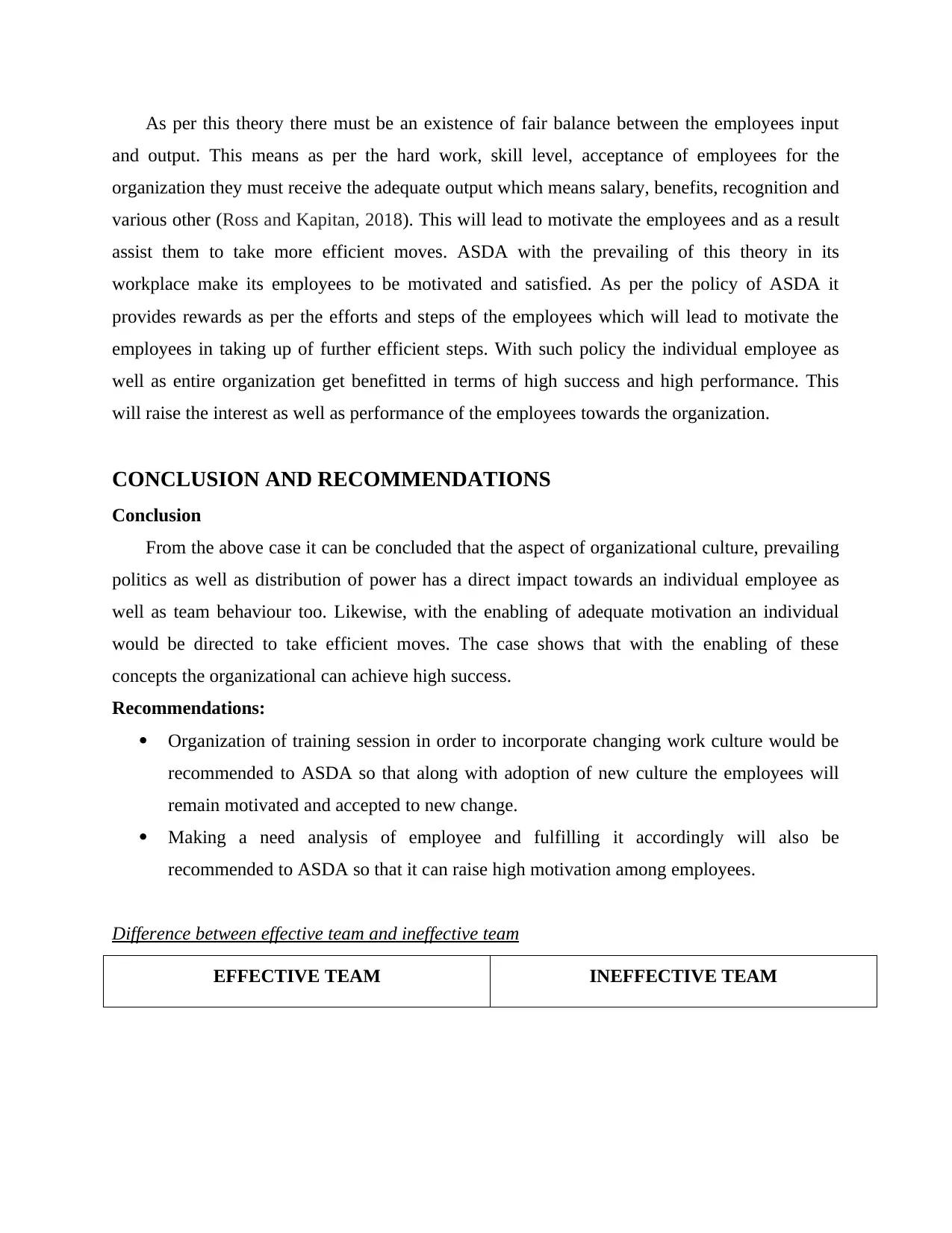
As per this theory there must be an existence of fair balance between the employees input
and output. This means as per the hard work, skill level, acceptance of employees for the
organization they must receive the adequate output which means salary, benefits, recognition and
various other (Ross and Kapitan, 2018). This will lead to motivate the employees and as a result
assist them to take more efficient moves. ASDA with the prevailing of this theory in its
workplace make its employees to be motivated and satisfied. As per the policy of ASDA it
provides rewards as per the efforts and steps of the employees which will lead to motivate the
employees in taking up of further efficient steps. With such policy the individual employee as
well as entire organization get benefitted in terms of high success and high performance. This
will raise the interest as well as performance of the employees towards the organization.
CONCLUSION AND RECOMMENDATIONS
Conclusion
From the above case it can be concluded that the aspect of organizational culture, prevailing
politics as well as distribution of power has a direct impact towards an individual employee as
well as team behaviour too. Likewise, with the enabling of adequate motivation an individual
would be directed to take efficient moves. The case shows that with the enabling of these
concepts the organizational can achieve high success.
Recommendations:
Organization of training session in order to incorporate changing work culture would be
recommended to ASDA so that along with adoption of new culture the employees will
remain motivated and accepted to new change.
Making a need analysis of employee and fulfilling it accordingly will also be
recommended to ASDA so that it can raise high motivation among employees.
Difference between effective team and ineffective team
EFFECTIVE TEAM INEFFECTIVE TEAM
and output. This means as per the hard work, skill level, acceptance of employees for the
organization they must receive the adequate output which means salary, benefits, recognition and
various other (Ross and Kapitan, 2018). This will lead to motivate the employees and as a result
assist them to take more efficient moves. ASDA with the prevailing of this theory in its
workplace make its employees to be motivated and satisfied. As per the policy of ASDA it
provides rewards as per the efforts and steps of the employees which will lead to motivate the
employees in taking up of further efficient steps. With such policy the individual employee as
well as entire organization get benefitted in terms of high success and high performance. This
will raise the interest as well as performance of the employees towards the organization.
CONCLUSION AND RECOMMENDATIONS
Conclusion
From the above case it can be concluded that the aspect of organizational culture, prevailing
politics as well as distribution of power has a direct impact towards an individual employee as
well as team behaviour too. Likewise, with the enabling of adequate motivation an individual
would be directed to take efficient moves. The case shows that with the enabling of these
concepts the organizational can achieve high success.
Recommendations:
Organization of training session in order to incorporate changing work culture would be
recommended to ASDA so that along with adoption of new culture the employees will
remain motivated and accepted to new change.
Making a need analysis of employee and fulfilling it accordingly will also be
recommended to ASDA so that it can raise high motivation among employees.
Difference between effective team and ineffective team
EFFECTIVE TEAM INEFFECTIVE TEAM
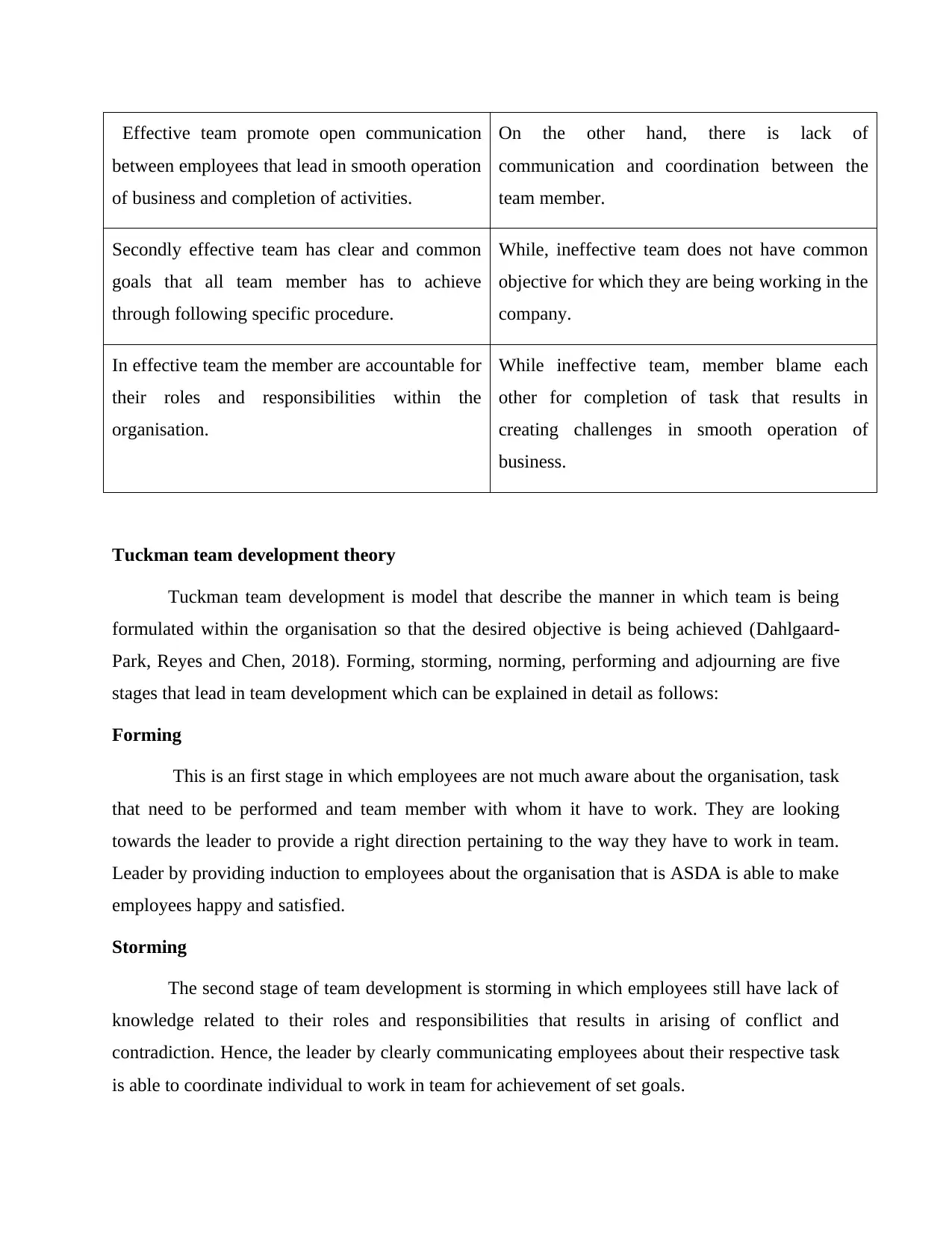
Effective team promote open communication
between employees that lead in smooth operation
of business and completion of activities.
On the other hand, there is lack of
communication and coordination between the
team member.
Secondly effective team has clear and common
goals that all team member has to achieve
through following specific procedure.
While, ineffective team does not have common
objective for which they are being working in the
company.
In effective team the member are accountable for
their roles and responsibilities within the
organisation.
While ineffective team, member blame each
other for completion of task that results in
creating challenges in smooth operation of
business.
Tuckman team development theory
Tuckman team development is model that describe the manner in which team is being
formulated within the organisation so that the desired objective is being achieved (Dahlgaard-
Park, Reyes and Chen, 2018). Forming, storming, norming, performing and adjourning are five
stages that lead in team development which can be explained in detail as follows:
Forming
This is an first stage in which employees are not much aware about the organisation, task
that need to be performed and team member with whom it have to work. They are looking
towards the leader to provide a right direction pertaining to the way they have to work in team.
Leader by providing induction to employees about the organisation that is ASDA is able to make
employees happy and satisfied.
Storming
The second stage of team development is storming in which employees still have lack of
knowledge related to their roles and responsibilities that results in arising of conflict and
contradiction. Hence, the leader by clearly communicating employees about their respective task
is able to coordinate individual to work in team for achievement of set goals.
between employees that lead in smooth operation
of business and completion of activities.
On the other hand, there is lack of
communication and coordination between the
team member.
Secondly effective team has clear and common
goals that all team member has to achieve
through following specific procedure.
While, ineffective team does not have common
objective for which they are being working in the
company.
In effective team the member are accountable for
their roles and responsibilities within the
organisation.
While ineffective team, member blame each
other for completion of task that results in
creating challenges in smooth operation of
business.
Tuckman team development theory
Tuckman team development is model that describe the manner in which team is being
formulated within the organisation so that the desired objective is being achieved (Dahlgaard-
Park, Reyes and Chen, 2018). Forming, storming, norming, performing and adjourning are five
stages that lead in team development which can be explained in detail as follows:
Forming
This is an first stage in which employees are not much aware about the organisation, task
that need to be performed and team member with whom it have to work. They are looking
towards the leader to provide a right direction pertaining to the way they have to work in team.
Leader by providing induction to employees about the organisation that is ASDA is able to make
employees happy and satisfied.
Storming
The second stage of team development is storming in which employees still have lack of
knowledge related to their roles and responsibilities that results in arising of conflict and
contradiction. Hence, the leader by clearly communicating employees about their respective task
is able to coordinate individual to work in team for achievement of set goals.
⊘ This is a preview!⊘
Do you want full access?
Subscribe today to unlock all pages.

Trusted by 1+ million students worldwide
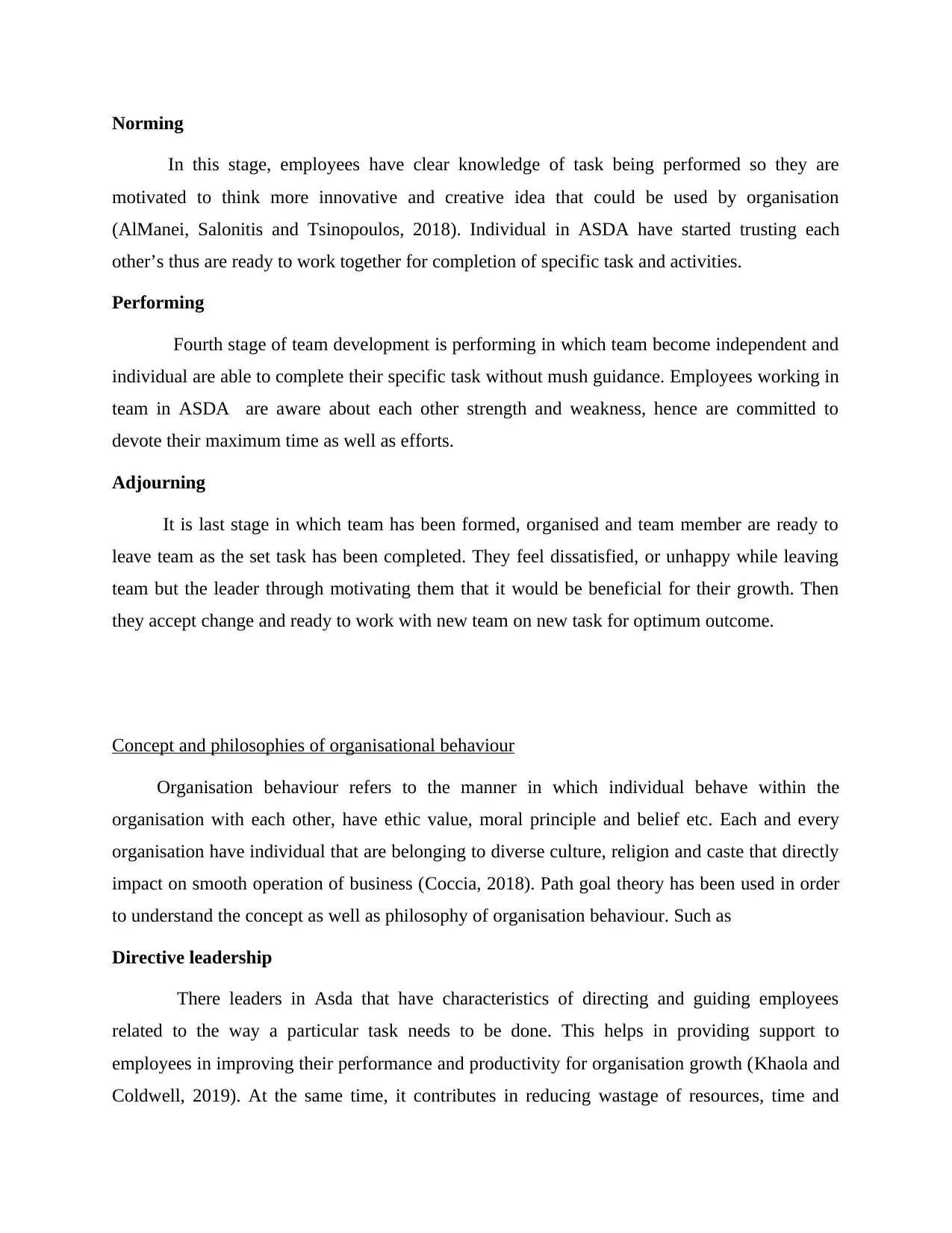
Norming
In this stage, employees have clear knowledge of task being performed so they are
motivated to think more innovative and creative idea that could be used by organisation
(AlManei, Salonitis and Tsinopoulos, 2018). Individual in ASDA have started trusting each
other’s thus are ready to work together for completion of specific task and activities.
Performing
Fourth stage of team development is performing in which team become independent and
individual are able to complete their specific task without mush guidance. Employees working in
team in ASDA are aware about each other strength and weakness, hence are committed to
devote their maximum time as well as efforts.
Adjourning
It is last stage in which team has been formed, organised and team member are ready to
leave team as the set task has been completed. They feel dissatisfied, or unhappy while leaving
team but the leader through motivating them that it would be beneficial for their growth. Then
they accept change and ready to work with new team on new task for optimum outcome.
Concept and philosophies of organisational behaviour
Organisation behaviour refers to the manner in which individual behave within the
organisation with each other, have ethic value, moral principle and belief etc. Each and every
organisation have individual that are belonging to diverse culture, religion and caste that directly
impact on smooth operation of business (Coccia, 2018). Path goal theory has been used in order
to understand the concept as well as philosophy of organisation behaviour. Such as
Directive leadership
There leaders in Asda that have characteristics of directing and guiding employees
related to the way a particular task needs to be done. This helps in providing support to
employees in improving their performance and productivity for organisation growth (Khaola and
Coldwell, 2019). At the same time, it contributes in reducing wastage of resources, time and
In this stage, employees have clear knowledge of task being performed so they are
motivated to think more innovative and creative idea that could be used by organisation
(AlManei, Salonitis and Tsinopoulos, 2018). Individual in ASDA have started trusting each
other’s thus are ready to work together for completion of specific task and activities.
Performing
Fourth stage of team development is performing in which team become independent and
individual are able to complete their specific task without mush guidance. Employees working in
team in ASDA are aware about each other strength and weakness, hence are committed to
devote their maximum time as well as efforts.
Adjourning
It is last stage in which team has been formed, organised and team member are ready to
leave team as the set task has been completed. They feel dissatisfied, or unhappy while leaving
team but the leader through motivating them that it would be beneficial for their growth. Then
they accept change and ready to work with new team on new task for optimum outcome.
Concept and philosophies of organisational behaviour
Organisation behaviour refers to the manner in which individual behave within the
organisation with each other, have ethic value, moral principle and belief etc. Each and every
organisation have individual that are belonging to diverse culture, religion and caste that directly
impact on smooth operation of business (Coccia, 2018). Path goal theory has been used in order
to understand the concept as well as philosophy of organisation behaviour. Such as
Directive leadership
There leaders in Asda that have characteristics of directing and guiding employees
related to the way a particular task needs to be done. This helps in providing support to
employees in improving their performance and productivity for organisation growth (Khaola and
Coldwell, 2019). At the same time, it contributes in reducing wastage of resources, time and
Paraphrase This Document
Need a fresh take? Get an instant paraphrase of this document with our AI Paraphraser
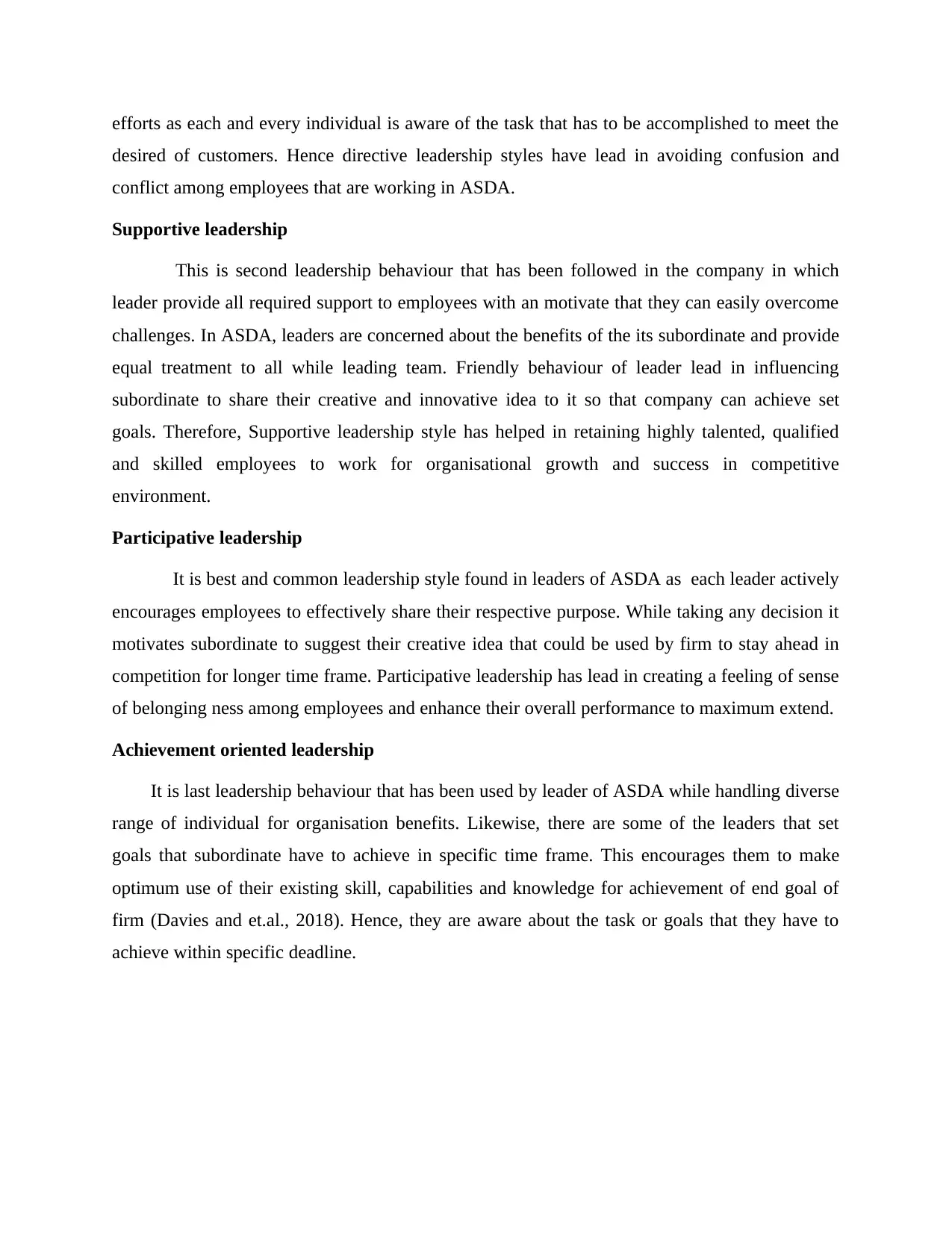
efforts as each and every individual is aware of the task that has to be accomplished to meet the
desired of customers. Hence directive leadership styles have lead in avoiding confusion and
conflict among employees that are working in ASDA.
Supportive leadership
This is second leadership behaviour that has been followed in the company in which
leader provide all required support to employees with an motivate that they can easily overcome
challenges. In ASDA, leaders are concerned about the benefits of the its subordinate and provide
equal treatment to all while leading team. Friendly behaviour of leader lead in influencing
subordinate to share their creative and innovative idea to it so that company can achieve set
goals. Therefore, Supportive leadership style has helped in retaining highly talented, qualified
and skilled employees to work for organisational growth and success in competitive
environment.
Participative leadership
It is best and common leadership style found in leaders of ASDA as each leader actively
encourages employees to effectively share their respective purpose. While taking any decision it
motivates subordinate to suggest their creative idea that could be used by firm to stay ahead in
competition for longer time frame. Participative leadership has lead in creating a feeling of sense
of belonging ness among employees and enhance their overall performance to maximum extend.
Achievement oriented leadership
It is last leadership behaviour that has been used by leader of ASDA while handling diverse
range of individual for organisation benefits. Likewise, there are some of the leaders that set
goals that subordinate have to achieve in specific time frame. This encourages them to make
optimum use of their existing skill, capabilities and knowledge for achievement of end goal of
firm (Davies and et.al., 2018). Hence, they are aware about the task or goals that they have to
achieve within specific deadline.
desired of customers. Hence directive leadership styles have lead in avoiding confusion and
conflict among employees that are working in ASDA.
Supportive leadership
This is second leadership behaviour that has been followed in the company in which
leader provide all required support to employees with an motivate that they can easily overcome
challenges. In ASDA, leaders are concerned about the benefits of the its subordinate and provide
equal treatment to all while leading team. Friendly behaviour of leader lead in influencing
subordinate to share their creative and innovative idea to it so that company can achieve set
goals. Therefore, Supportive leadership style has helped in retaining highly talented, qualified
and skilled employees to work for organisational growth and success in competitive
environment.
Participative leadership
It is best and common leadership style found in leaders of ASDA as each leader actively
encourages employees to effectively share their respective purpose. While taking any decision it
motivates subordinate to suggest their creative idea that could be used by firm to stay ahead in
competition for longer time frame. Participative leadership has lead in creating a feeling of sense
of belonging ness among employees and enhance their overall performance to maximum extend.
Achievement oriented leadership
It is last leadership behaviour that has been used by leader of ASDA while handling diverse
range of individual for organisation benefits. Likewise, there are some of the leaders that set
goals that subordinate have to achieve in specific time frame. This encourages them to make
optimum use of their existing skill, capabilities and knowledge for achievement of end goal of
firm (Davies and et.al., 2018). Hence, they are aware about the task or goals that they have to
achieve within specific deadline.
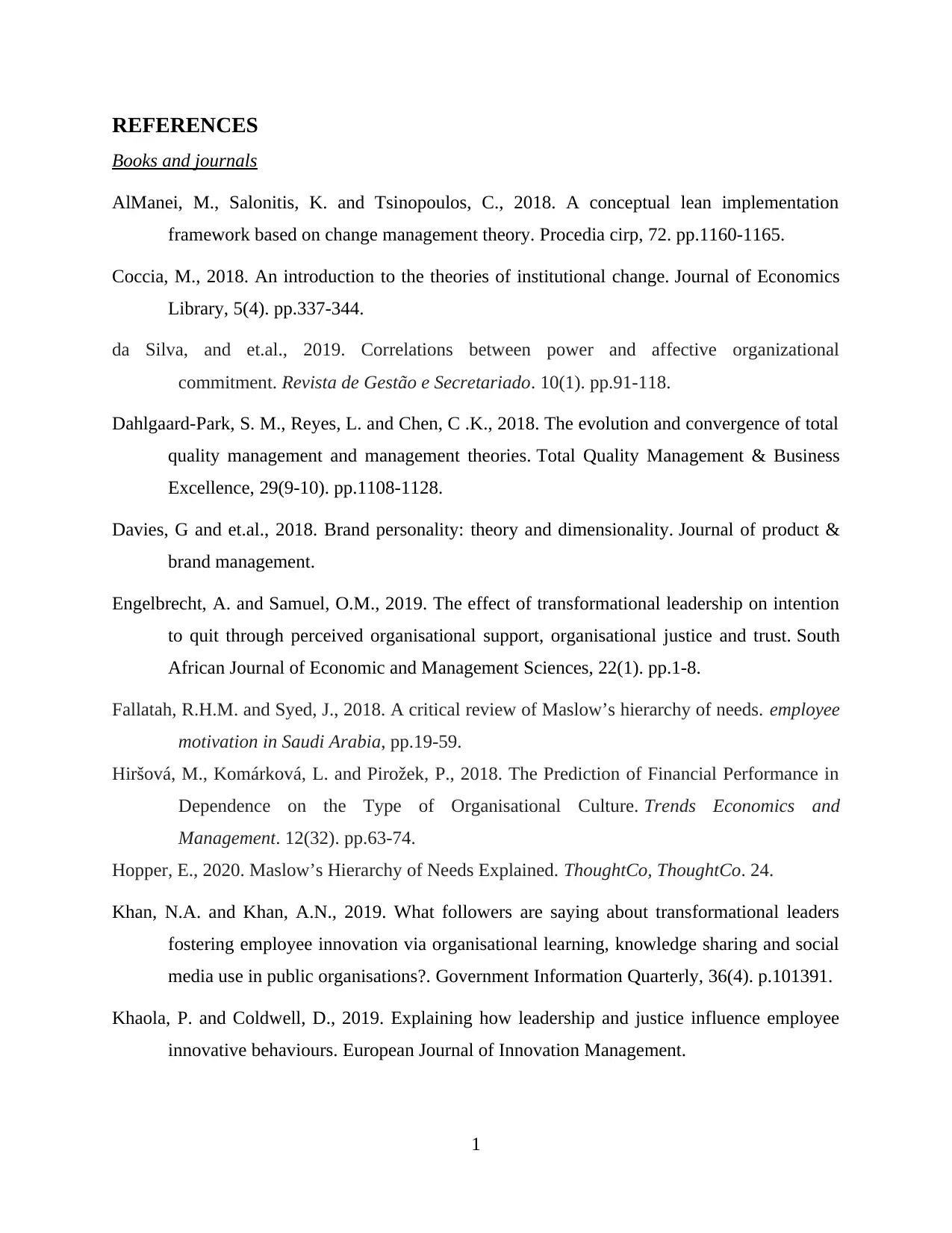
REFERENCES
Books and journals
AlManei, M., Salonitis, K. and Tsinopoulos, C., 2018. A conceptual lean implementation
framework based on change management theory. Procedia cirp, 72. pp.1160-1165.
Coccia, M., 2018. An introduction to the theories of institutional change. Journal of Economics
Library, 5(4). pp.337-344.
da Silva, and et.al., 2019. Correlations between power and affective organizational
commitment. Revista de Gestão e Secretariado. 10(1). pp.91-118.
Dahlgaard-Park, S. M., Reyes, L. and Chen, C .K., 2018. The evolution and convergence of total
quality management and management theories. Total Quality Management & Business
Excellence, 29(9-10). pp.1108-1128.
Davies, G and et.al., 2018. Brand personality: theory and dimensionality. Journal of product &
brand management.
Engelbrecht, A. and Samuel, O.M., 2019. The effect of transformational leadership on intention
to quit through perceived organisational support, organisational justice and trust. South
African Journal of Economic and Management Sciences, 22(1). pp.1-8.
Fallatah, R.H.M. and Syed, J., 2018. A critical review of Maslow’s hierarchy of needs. employee
motivation in Saudi Arabia, pp.19-59.
Hiršová, M., Komárková, L. and Pirožek, P., 2018. The Prediction of Financial Performance in
Dependence on the Type of Organisational Culture. Trends Economics and
Management. 12(32). pp.63-74.
Hopper, E., 2020. Maslow’s Hierarchy of Needs Explained. ThoughtCo, ThoughtCo. 24.
Khan, N.A. and Khan, A.N., 2019. What followers are saying about transformational leaders
fostering employee innovation via organisational learning, knowledge sharing and social
media use in public organisations?. Government Information Quarterly, 36(4). p.101391.
Khaola, P. and Coldwell, D., 2019. Explaining how leadership and justice influence employee
innovative behaviours. European Journal of Innovation Management.
1
Books and journals
AlManei, M., Salonitis, K. and Tsinopoulos, C., 2018. A conceptual lean implementation
framework based on change management theory. Procedia cirp, 72. pp.1160-1165.
Coccia, M., 2018. An introduction to the theories of institutional change. Journal of Economics
Library, 5(4). pp.337-344.
da Silva, and et.al., 2019. Correlations between power and affective organizational
commitment. Revista de Gestão e Secretariado. 10(1). pp.91-118.
Dahlgaard-Park, S. M., Reyes, L. and Chen, C .K., 2018. The evolution and convergence of total
quality management and management theories. Total Quality Management & Business
Excellence, 29(9-10). pp.1108-1128.
Davies, G and et.al., 2018. Brand personality: theory and dimensionality. Journal of product &
brand management.
Engelbrecht, A. and Samuel, O.M., 2019. The effect of transformational leadership on intention
to quit through perceived organisational support, organisational justice and trust. South
African Journal of Economic and Management Sciences, 22(1). pp.1-8.
Fallatah, R.H.M. and Syed, J., 2018. A critical review of Maslow’s hierarchy of needs. employee
motivation in Saudi Arabia, pp.19-59.
Hiršová, M., Komárková, L. and Pirožek, P., 2018. The Prediction of Financial Performance in
Dependence on the Type of Organisational Culture. Trends Economics and
Management. 12(32). pp.63-74.
Hopper, E., 2020. Maslow’s Hierarchy of Needs Explained. ThoughtCo, ThoughtCo. 24.
Khan, N.A. and Khan, A.N., 2019. What followers are saying about transformational leaders
fostering employee innovation via organisational learning, knowledge sharing and social
media use in public organisations?. Government Information Quarterly, 36(4). p.101391.
Khaola, P. and Coldwell, D., 2019. Explaining how leadership and justice influence employee
innovative behaviours. European Journal of Innovation Management.
1
⊘ This is a preview!⊘
Do you want full access?
Subscribe today to unlock all pages.

Trusted by 1+ million students worldwide
1 out of 13
Related Documents
Your All-in-One AI-Powered Toolkit for Academic Success.
+13062052269
info@desklib.com
Available 24*7 on WhatsApp / Email
![[object Object]](/_next/static/media/star-bottom.7253800d.svg)
Unlock your academic potential
Copyright © 2020–2025 A2Z Services. All Rights Reserved. Developed and managed by ZUCOL.





